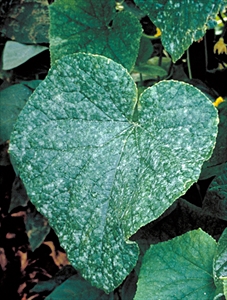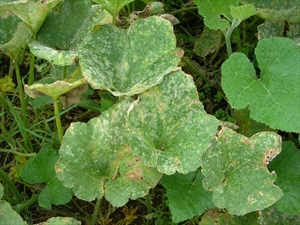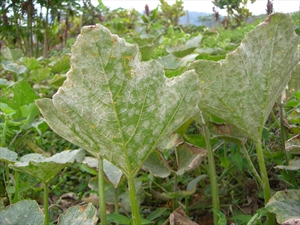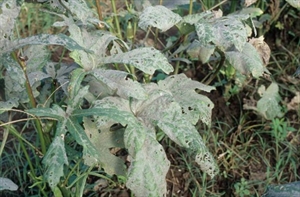Cucumber powdery mildew
Pacific Pests, Pathogens, Weeds & Pesticides - Online edition
Pacific Pests, Pathogens, Weeds & Pesticides
Cucumber powdery mildew (063)
Two species have been recorded: Podosphaera xanthii and Golovinomyces cichoracearum; previously Sphaerotheca fuliginea and Erysiphe cichoracearum, respectively. These are the names of the sexual forms of the powdery mildews, but in Pacific island countries only the asexual form has been found, known as Oidium species. Unfortunately, unless the Oidium form is examined miscoscopically soon after collecting identification is difficult.
Even in 1981, the Survey of Agricultural Pests and Diseases1 recognised that samples identified as Sphaerotheca fuliginea were likely confused with Erysiphe cichoracearum. Since then other taxonomic complications have arisen from molecular analyses. Golovinomyces cichoracearum, for instance, is recognised as a 'species complex', i.e., it is more than one species.
In the interim, and while the taxonomy is better understood, it is best to refer to all powdery mildew fungi of cucurbits from Pacific islands as Oidium species.
CABI records Golovinomyces cichoracearum from Asia, Africa, North, South and Central America, the Caribbean, Europe, Oceania2. It is recorded from Australia, American Samoa, Fiji, New Caledonia, and New Zealand. Podosphaera xanthii is recorded from Asia, Africa, North and South America, the Caribbean, Europe, Oceania. It is recorded from Australia, New Zealand and Samoa.
Cucurbits are hosts; common cucurbits are cucumber, melon, pumpkin, squash and zucchini. Some legumes and ornamentals are also susceptible to infection.
The fungus is unusual in that it cannot survive in the absence of a living host. It is also unusual in that it grows over the leaf surface, and that is the reason why the leaf (above and below) appears white (Photos 1-3). In order to feed, the fungus sends special cells into the leaf and these extract the food it needs for growth. Spores, called 'conidia', are produced in chains on single strands of its cottony growth that stand erect from the leaf surface. The spores are spread in the wind; they need high humidity to germinate, but not water. The time between infection and symptoms is short, 3-5 days (depending on temperatures). Spread is fast, especially if plants are close together, humidity is high, and there is no rain.
The disease can be a major problem. Powdery mildews seldom kill their hosts, but use their nutrients, reduce photosynthesis, impair growth and reduce yields. Early death of the leaves lowers market quality because fruit become sunburnt, ripen prematurely, do not store well, or have poor flavour. The size and number of fruits is also reduced. In addition, plants with powdery mildew are more likely to become infected with other diseases, gummy stem blight in particular (see Fact Sheet No. 07).
Look for white, powdery fungal spots on upper leaf surfaces, and on petioles and stems. Look for the fungus on the shaded older leaves. Infection on the underside is often not clear because of the lighter colour of the leaf; although on pumpkin leaves this is not always so (Photo 3). The fungal spots expand and multiply rapidly, so look for leaves that gradually turn yellow, then brown, dry out and die.
CULTURAL CONTROL
Cultural control measures are important to reduce the disease; do the follow:
Before planting:
- Plant in sunny places, and, if possible, choose areas with good air circulation.
- Do not plant successive crops of cucurbits on the same land; practice crop rotation.
- Do not plant new crops next to those that have the disease; otherwise spread of the disease to the new crop will be rapid and devastating.
During growth:
- Remove weeds from within and around the crop: many weeds are hosts of powdery mildew, so make sure they are controlled.
After harvest:
- Collect crop debris after harvest and burn it.
RESISTANT VARIETIES
There are varieties of cucumber, melon, pumpkin and squash with tolerance to powdery mildew. Check company descriptions of varieties, but note that the varieties may not be tolerant to the powdery mildew species in the Pacific.
CHEMICAL CONTROL
If fungicides are used, inspect the crop regularly to detect when infections first occur. Start spraying immediately symptoms are seen, and spray routinely every 7-10 days, depending on the severity of the disease. Do the following:
- For large commercial plantings, apply wettable sulphur products, chlorothalonil (also useful for gummy stem blight control) or check availability of other products (e.g., triazoles).
- If following an organic regime, use products containing horticultural oil, potassium bicarbonate or wettable sulphur. The last two are best applied before disease symptoms appear. Oils are eradicants, meaning they can cure plants that are already infected, but also have some protectant activity.
- Apply wettable sulphur in the early morning or evening, at the coolest times of the day. Never spray sulphur within 2 weeks of the last application of an oil spray. Also, sulphur can burn the leaves, so read the label carefully before applying. (Wettable sulphur has been used for many years for powdery mildew control.)
- Where the number of plants is small, use milk: normal strength milk diluted 1 part in 10 parts of water.
____________________
When using a pesticide, always wear protective clothing and follow the instructions on the product label, such as dosage, timing of application, and pre-harvest interval. Recommendations will vary with the crop and system of cultivation. Expert advice on the most appropriate pesticides to use should always be sought from local agricultural authorities.
AUTHORS Helen Tsatsia & Grahame Jackson
1Dingley JM, et al. (1981) Survey of Agricultural Pests and Diseases Technical Report Volume2. South Pacific Bureau for Economic Co-operation, United National Development Programme, Food and Agricultural Organization of the United Nation. Rome, Italy. 2CABI (2017) Golovinomyces cichoracearum (powdery mildew) Crop Protection Compendium. (https://www.cabi.org/cpc/datasheet/22065) and from CABI (2016) Podosphaera xanthii (powdery mildew of cucurbits) Crop Protection Compendium. (https://www.cabi.org/cpc/datasheet/50922); and from (including Photo 4) McKenzie E (2013) Golovinomyces cucurbitacearum: PaDIL - (http://www.padil.gov.au).
Produced with support from the Australian Centre for International Agricultural Research under project PC/2010/090: Strengthening integrated crop management research in the Pacific Islands in support of sustainable intensification of high-value crop production, implemented by the University of Queensland and the Secretariat of the Pacific Community.







